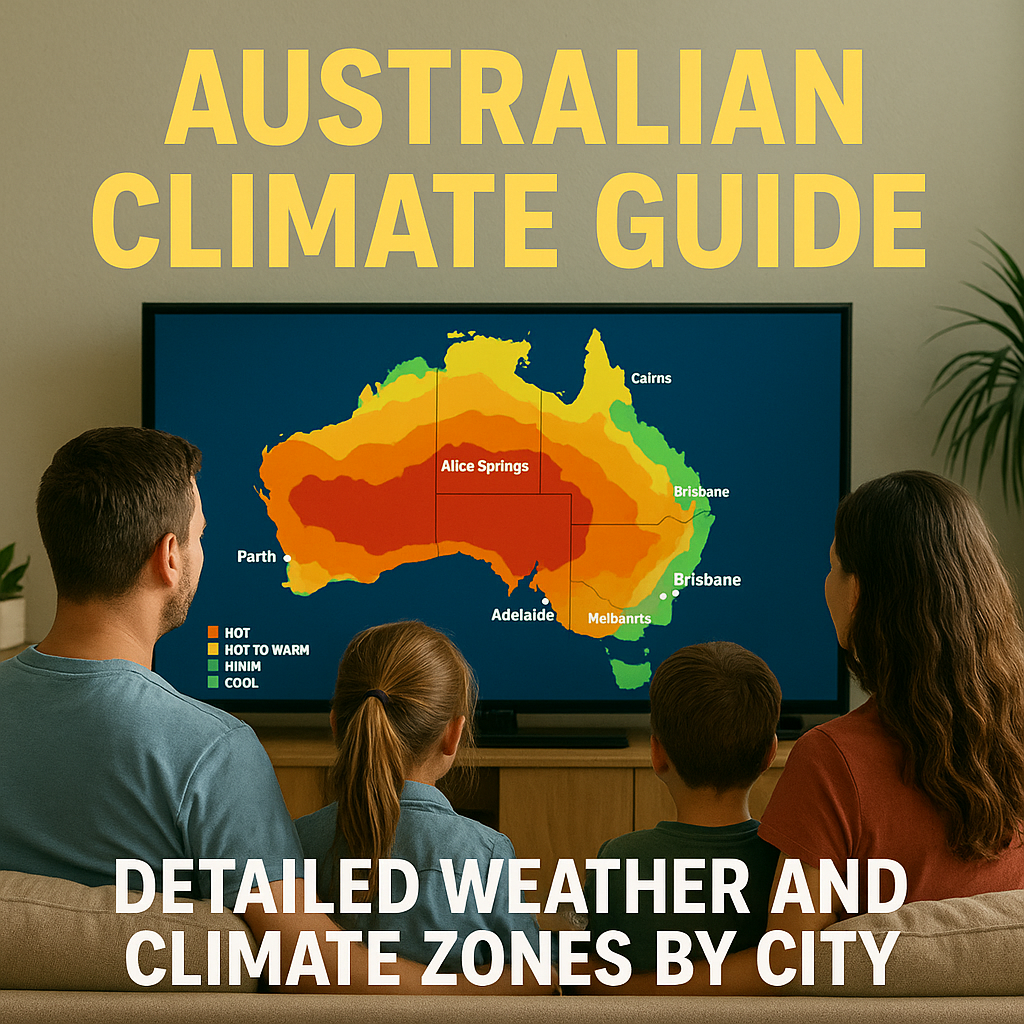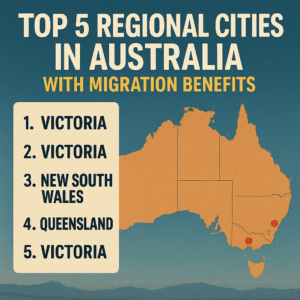Explore Australia’s diverse climate zones, city-specific weather patterns, seasonal variations, and climate change impacts to plan your visit or relocation confidently.
Introduction
Australia’s vast geography covers several distinct climate zones, from tropical north regions with monsoonal rains to temperate southern cities with four distinct seasons. Understanding the weather in Australian cities and their climatic differences is essential for planning travel, relocation, or daily life. This guide outlines the national climate framework, detailed city weather profiles, seasonal trends, climate change impacts, and adaptation tips for 2025 and beyond.
H2: The Australian Climate Zones Explained
Australia’s climate classification is standardized via the National Construction Code (NCC), which divides the country into 8 major climate zones based on temperature, humidity, rainfall, and seasonal variation. These zones help govern building standards but also serve as a useful framework for understanding weather patterns.
| Zone | Area Covered | Key Characteristics | Example Cities/Regions |
|---|---|---|---|
| 1 | Northern coastal belt from Exmouth to south of Townsville | High humidity summer, warm mild winter, tropical monsoonal climate | Darwin, Cairns (wet/dry season) |
| 2 | Coastal Queensland to south of Coffs Harbour | Warm humid summers, mild winters, subtropical climate | Brisbane, coastal NSW towns |
| 3 | Northern central Australia inland deserts | Hot dry summers, warm winters, desert climate | Alice Springs, Tennant Creek |
| 4 | Southern central Australia inland areas | Hot dry summers, cool winters, arid interior | Broken Hill, Coober Pedy |
| 5 | Coastal strips of WA, SA, NSW and hinterlands | Warm temperate with variable rainfall | Perth coastal, Sydney coastal suburbs |
| 6 | Southern coastal and hinterland regions | Mild temperate, winter rainfall | Melbourne, Adelaide, coastal Victoria |
| 7 | Sub-alpine and Tasmanian cooler regions | Cool temperate, cold winters, sometimes snow | Canberra, Hobart, highlands of Vic & NSW |
| 8 | Alpine zones of Victoria, NSW and Tasmania | Alpine, cold, snowy winters | Snowy Mountains, Victorian Alps |
These zones reflect large climatic shifts, from tropical wet-dry cycles and heat extremes to cold winters and alpine snow. Your city’s zone predicts its average temperature range, rainfall pattern, and seasonal weather.
H2: City-Specific Climate Overviews and Weather Patterns
Darwin: Tropical Wet-Dry Climate
Darwin, located in Zone 1, experiences a tropical climate with two distinct seasons: a hot, wet monsoon season (Nov-Apr) with heavy rainfall and humidity, and a warm, dry “dry season” (May-Oct). Temperatures remain high year-round, averaging 21–33°C. The wet season brings lush greenery but also risks of flooding and cyclones.
Brisbane: Humid Subtropical
Situated in Zone 2, Brisbane has warm, humid summers with average temperatures around 25°C and frequent summer thunderstorms. Winters are mild and dry. Seasonal rainfall peaks in late summer and early autumn, supporting lush vegetation. Flooding from storms is an occasional risk.
Sydney: Warm Temperate Coastal
Sydney (Zone 5 coastal) features mild winters and warm, humid summers, with average annual rainfall around 1200mm, fairly evenly spread. Summer heatwaves, occasional storms, and urban flooding challenges are notable. Winters rarely drop below 14°C.
Melbourne: Mild Temperate with Rapid Changes
Melbourne lies in Zone 6, characterized by four distinct seasons with more variable and rapidly shifting weather. It experiences cooler winters (5-15°C), warm summers (14-26°C), and moderate rainfall mostly in winter and spring. Its notorious “four seasons in one day” phenomenon results from the convergence of maritime and inland air masses.
Perth: Mediterranean Climate
Perth (Zone 5, coastal WA) has hot, dry summers with average highs over 30°C, and mild, wet winters. Annual rainfall is about 730mm, mostly between May and August. The climate supports drought-tolerant vegetation and outdoor lifestyles but also faces summer heatwave and bushfire risks.
Adelaide: Mediterranean Climate
Adelaide shares a similar climate to Perth (Zone 5-6), with hot dry summers and cool wet winters. Average temperatures range from 13 to 23°C. The city is prone to summer heatwaves and occasional drought, influencing water resource management.
Hobart: Cool Temperate Oceanic
Located in Zone 7, Tasmania’s capital has cool, mild summers and cold winters with occasional snow in higher areas. Rainfall is moderate (around 616mm annually) and spread throughout the year. Conditions favor certain temperate crops and offer distinctive seasonal changes.
Canberra: Continental Mild Temperate
Canberra in Zone 7 experiences cold winters with frost and occasional snow, and warm summers. Annual rainfall is moderate but less than coastal cities. Temperature variations are pronounced, with summer highs often exceeding 25°C and winter lows below zero.
H2: Seasonal Weather and Travel Tips Across Cities
Summer (December–February)
Generally hot across most cities, with northern areas experiencing intense humidity and heavy rainfalls, while southern cities see hot dry conditions and heatwaves. Coastal cities may have afternoon sea breezes. Protection against UV radiation and heat stress is essential nationwide.
Autumn (March–May)
Cooling begins in southern cities, with less humidity and milder temperatures. Rainfall increases in some areas, especially in Melbourne and Sydney, making this a pleasant travel season.
Winter (June–August)
Winters are mild in northern and coastal cities but cold in inland and southern regions, with freezing temperatures and frosts common in Canberra and Tasmania. Snowfalls occur mainly in alpine zones. Cities like Brisbane and Darwin remain warm and comfortable.
Spring (September–November)
Warming trends return with blossoming flora and variable rainfall. It’s a favorable season for outdoor activities and travel planning, avoiding extreme heat or cold.
H2: Climate Change Impacts on Australian Cities
Australia is experiencing significant climate shifts over recent decades:
- Average temperatures have risen by approximately 1.4°C since 1910.
- More frequent and intense heatwaves threaten urban populations, particularly in southern capitals.
- Bushfire seasons have lengthened and intensified, especially in Mediterranean and temperate zones.
- Droughts and flooding increase variability in rainfall patterns, affecting agriculture and water security.
- Coastal cities face challenges from rising sea levels and storm surges.
Future projections indicate hotter, drier conditions in many southern cities, while northern tropical regions may experience altered monsoon patterns with stronger wet seasons. Adaptation strategies including urban greening, improved water management, and community resilience programs are underway.
Geography and Climate Zones
Australia’s weather in major cities is defined by pronounced diversity, molded by geography and climate zones. From Darwin’s tropical monsoons to Melbourne’s temperate fluctuations and Perth’s Mediterranean dryness, understanding these patterns equips residents and visitors for better planning and comfort. Keeping abreast of climate change impacts ensures preparedness for evolving extremes in this vast island continent’s climate landscape.


